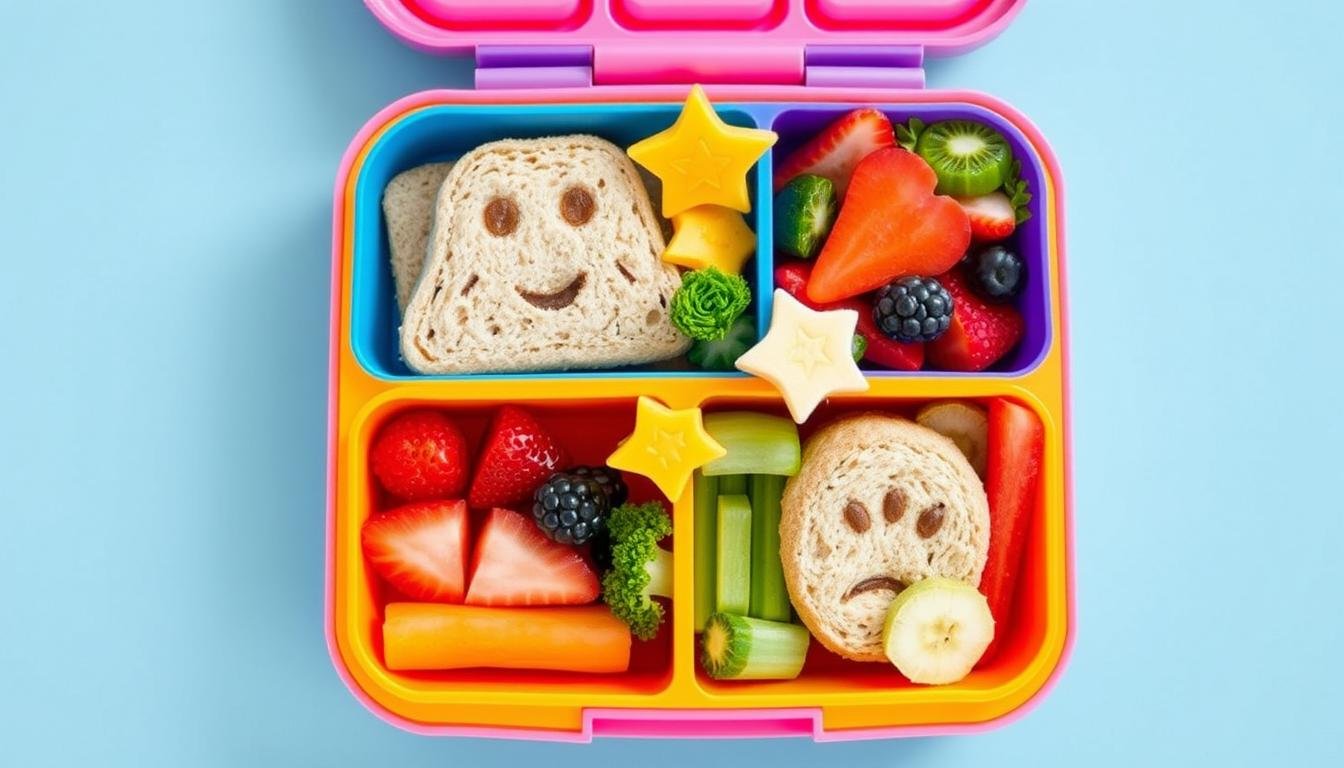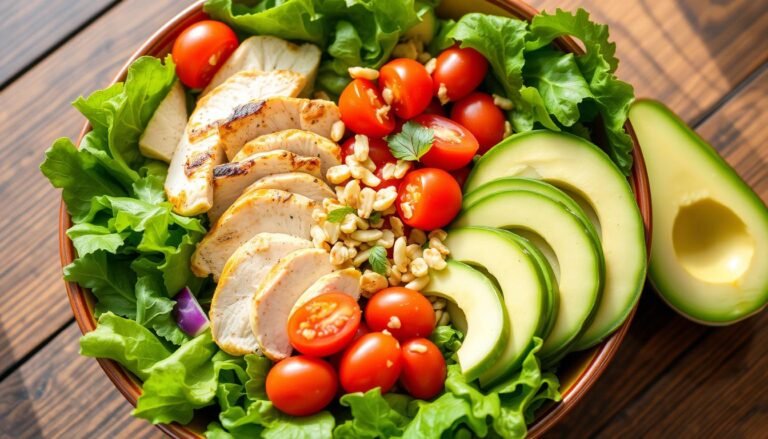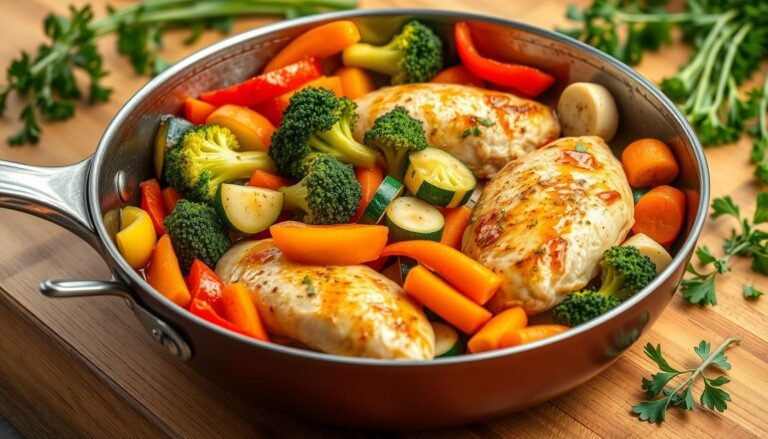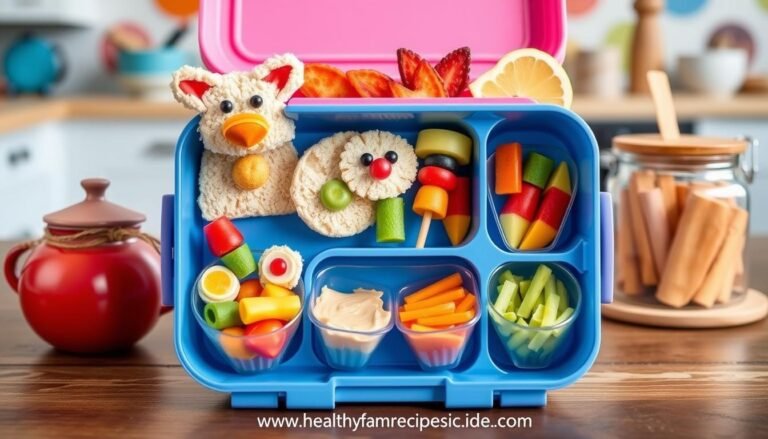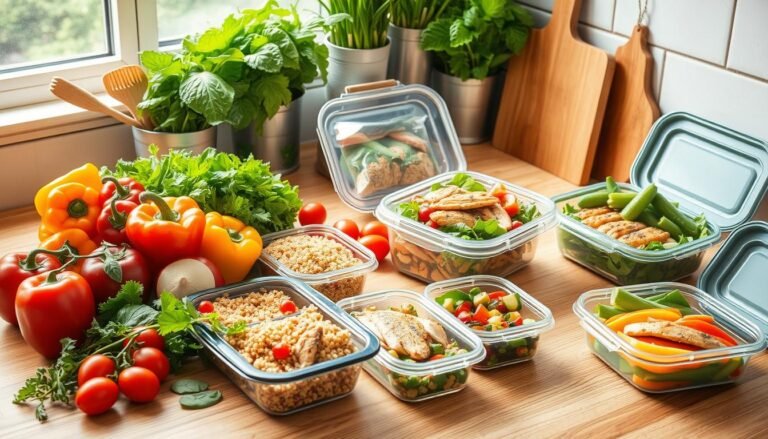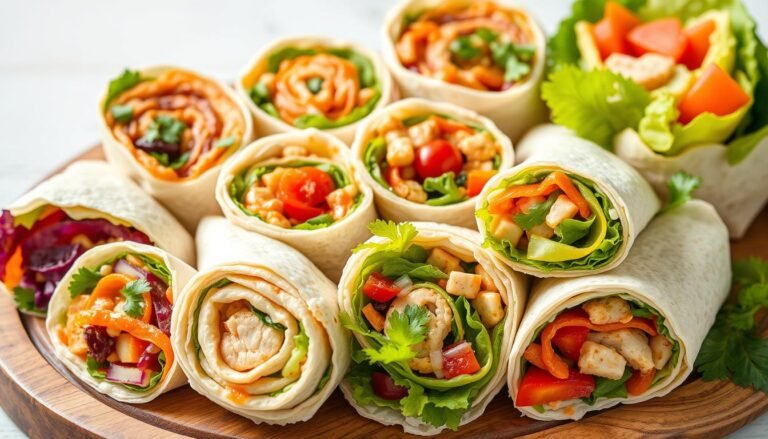Bento Box Lunches: Quick and Easy for Work or School
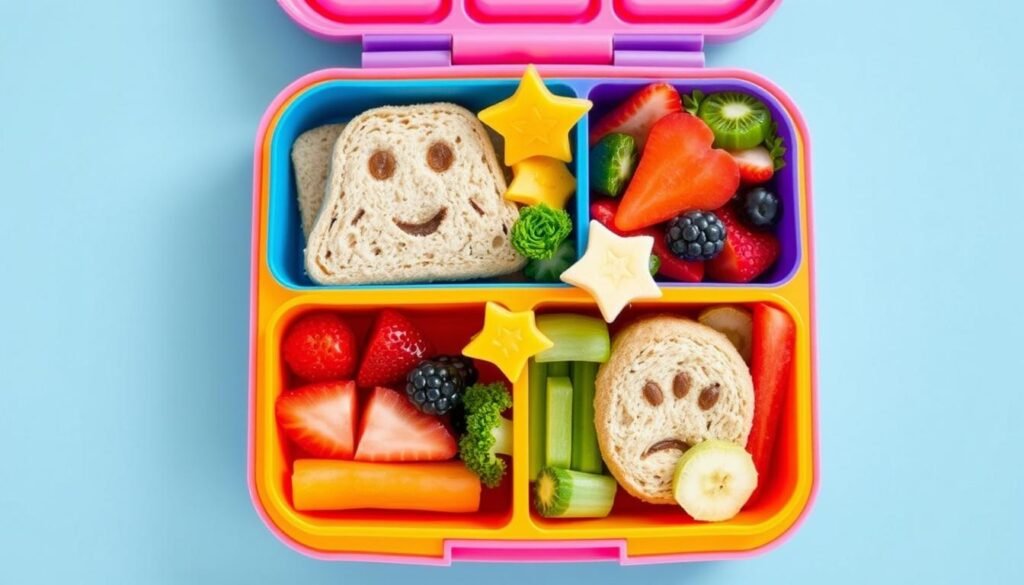
Table of Contents
Every parent faces the daily lunch-packing challenge. Mornings are busy, and finding meals that kids like can be tough. Bento box lunches have changed how I pack lunches, making it fun and creative.
Japanese cuisine has given us a great way to pack healthy lunches. Bento box lunches are more than just food. They’re about making meals that kids look forward to eating. With special containers, packing lunch becomes a fun activity that ensures kids get all the nutrients they need.
There are many ideas for bento box lunches, like rotisserie chicken salad or veggie muffins. By using colorful ingredients and fun presentations, you can make meals that are both healthy and exciting for your kids.
Key Takeaways
- Bento box lunches simplify meal preparation
- Offers balanced nutrition in kid-friendly portions
- Encourages creativity in meal planning
- Keeps food fresh and separate
- Makes lunch exciting for children
What is a Bento Box?
Japanese cuisine has always been about lunch on-the-go with the bento box. It’s more than a food container. It shows creativity, nutrition, and how to eat right.
Origins of the Bento Box
The bento box started in the Kamakura Period (1185–1333). It changed a lot over time. By the Edo period (1603–1868), it became a sign of status and skill in cooking.
Key Components of a Bento Box
- Rice as the primary base
- Protein (fish or meat)
- Pickled or cooked vegetables
- Small dessert or fruit section
Traditional bento follows the ichi-juu-san-sai rule. This means “one soup, three sides.” It makes sure the meal is balanced and healthy.
Benefits of Using Bento Boxes
| Benefit | Description |
|---|---|
| Portion Control | Compartments help manage serving sizes |
| Meal Variety | Multiple food sections encourage diverse nutrition |
| Eco-Friendly | Reduces disposable packaging waste |
| Aesthetic Presentation | Promotes visually appealing meal preparation |
“A bento box is not just a meal, it’s a culinary canvas that reflects care, creativity, and cultural tradition.”
Bento boxes are great for a quick lunch on-the-go or for trying Japanese food. They mix nutrition, style, and the right amount of food.
Essential Bento Box Ingredients
Creating delicious meal prep and lunchbox ideas requires understanding the perfect balance of nutrients. Bento boxes offer an exciting way to pack a variety of foods that keep you energized throughout the day.
Your bento box should be a colorful canvas of nutrition. It combines different food groups to create a wholesome meal. Let’s explore the essential ingredients that make a perfect bento box:
Protein Powerhouses
Proteins are crucial for keeping you full and maintaining energy. Your healthy lunch ideas can include:
- Lean chicken breast
- Grilled fish like salmon
- Tofu or tempeh for vegetarian options
- Hard-boiled eggs
- Legumes such as lentils and black beans
Vibrant Fruits and Vegetables
Colorful produce adds essential vitamins and makes your meal prep visually appealing:
- Cherry tomatoes
- Cucumber slices
- Baby carrots
- Bell pepper strips
- Berries and melon chunks
Grains and Carbohydrates
Whole grains provide sustained energy for your lunchbox ideas:
- Quinoa
- Brown rice
- Whole grain bread
- Soba noodles
“A well-balanced bento box is like a nutritional symphony, where every ingredient plays a crucial role.” – Nutrition Expert
By combining these ingredients, you’ll create delicious, nutritious meals. These meals make meal prep exciting and enjoyable.
Types of Bento Boxes to Consider
Exploring Japanese cuisine shows us many lunch options in bento boxes. These containers are more than meals; they’re a form of art. They make meal planning fun.
Choosing the right bento box is exciting. You’ll find many options that fit your taste and lifestyle:
Traditional Japanese Bento
Traditional Japanese bento boxes are steeped in culture. They balance flavors and look great. Ekiben and Kyaraben show off Japanese cooking skills.
- Hinomaru bento: White rice with a red umeboshi plum
- Aisai bento: Meals made with love
- Regional specialty bento boxes with local ingredients
Western-style Bento Boxes
Today’s bento boxes meet Western tastes. They’re great for busy people and students.
- Stainless steel containers with many compartments
- Plastic boxes that don’t leak
- Foldable silicone for easy storage
Eco-friendly Bento Options
More people want eco-friendly lunch options. Pick materials that are good for you and the planet.
- Bamboo containers
- Stainless steel boxes
- Glass containers with sleeves
“A well-designed bento box is not just a meal container, but a statement of personal style and commitment to mindful eating.”
Your perfect bento box depends on what you like, your lifestyle, and your eco values. Think about the material, size, compartments, and how easy it is to carry.
Meal Prep Tips for Bento Boxes
Start a new lunch routine with smart meal prep. Bento boxes are great for healthy lunches that save time. They keep your meals exciting. With planning, weekday lunches become easy.
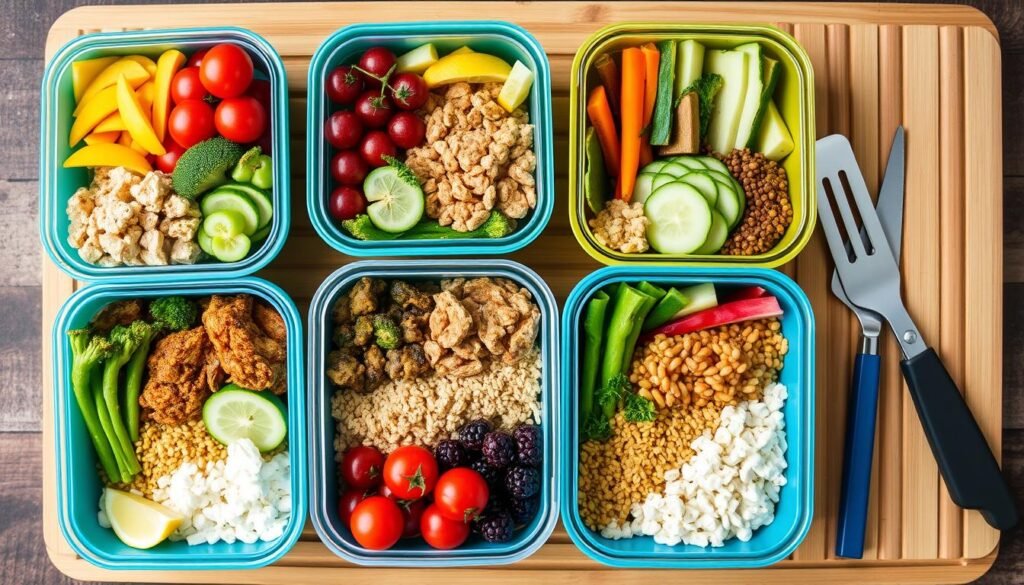
Meal prep for bento boxes needs a smart plan. Here are key tips for easy lunch prep:
Plan Ahead for the Week
Start with a weekly meal plan. Follow these steps:
- Create a meal prep calendar on Sunday
- Choose recipes that can be prepped in batches
- Mix and match ingredients for variety
- Shop for ingredients in advance
Batch Cooking Essentials
Batch cooking is a lifesaver for busy people. Prepare large quantities of versatile proteins and grains that can be mixed into multiple bento box configurations. Here are some batch cooking tips:
- Cook proteins like chicken, turkey, or tofu in bulk
- Prepare grains such as quinoa or brown rice
- Chop vegetables for quick assembly
- Store components separately to maintain freshness
“Meal prep is not about perfection, but about making healthy eating more convenient and enjoyable.”
Storage Solutions
Proper storage keeps food fresh and safe. Bento boxes can last up to 5 days in the fridge with the right containers:
- Use airtight glass or BPA-free plastic containers
- Invest in compartmentalized bento boxes
- Keep wet and dry ingredients separate
- Use silicone cups to prevent food mixing
With these meal prep tips, you’ll enjoy delicious, healthy bento box lunches. They make eating well simple and fun.
Creative Bento Box Combinations
Turning your lunchbox into a fun adventure starts with creativity and planning. Bento Box Lunches let you make healthy meals that look great too.
Balanced Protein and Veggie Mix
Creating a balanced bento box needs a careful choice of ingredients. Your mix of protein and veggies can make lunchtime special.
- Grilled chicken strips with roasted vegetables
- Quinoa salad with mixed greens
- Hard-boiled eggs with cucumber sticks
- Tofu cubes with colorful bell pepper slices
Fun and Kid-Friendly Combinations
Make lunch fun for kids with colorful meals. Creative presentation can make eating healthier a joy.
- Mini sandwiches cut into animal shapes
- Colorful fruit kebabs
- Cheese cubes with whole-grain crackers
- Rolled turkey and cheese pinwheels
Seasonal Bento Ideas
Use fresh, seasonal produce to keep your lunches exciting all year.
| Season | Suggested Bento Combination |
|---|---|
| Summer | Fresh berries, cold pasta salad, grilled chicken |
| Fall | Roasted squash, apple slices, turkey roll-ups |
| Winter | Hearty lentil soup, roasted root vegetables |
| Spring | Asparagus spears, spring peas, salmon bites |
“A well-designed bento box is like an artistic canvas for your lunch, combining nutrition and creativity.” – Culinary Expert
Great Bento Box Lunches come from trying new flavors and looks. Your healthy meals can be a daily treat for your body and soul.
Easy Bento Box Recipes
Learning to make healthy lunches can change your meal prep game. Bento boxes are a fun and easy way to pack meals that taste great and look good. Here are some simple recipes to make meal planning a snap.
Quinoa and Roasted Vegetable Bowl
This recipe is a mix of taste and nutrition. Start with quinoa, a protein-packed base. Then, roast a variety of colorful veggies like:
- Bell peppers
- Zucchini
- Carrots
- Cherry tomatoes
Add chickpeas for more protein. Finish with a light lemon-olive oil dressing.
Chicken Teriyaki with Rice
Make tender chicken teriyaki ahead for a quick, tasty meal. Use lean chicken breast marinated in homemade teriyaki sauce. Serve with brown rice and steamed edamame.
Mediterranean Hummus Bento
Make a Mediterranean-style lunch with these items:
| Ingredient | Quantity |
|---|---|
| Hummus | 1/4 cup |
| Whole wheat pita | 1 small |
| Cucumber slices | 1/2 cup |
| Feta cheese | 2 tablespoons |
| Olives | 5-6 pieces |
“A well-planned bento box is like a delicious puzzle of nutrition and flavor!” – Nutritionist Sarah Green
These recipes show that meal planning can be both enjoyable and healthy. Keep your bento box in the fridge and eat it within 5 days for the best taste.
Bento Box for Dietary Restrictions
Dealing with dietary restrictions can be tough. But, bento boxes are a great way to make healthy lunches for different needs. With some planning and creativity, you can make lunches that taste good and meet specific dietary needs.
Gluten-Free Bento Strategies
For gluten-free bento boxes, use ingredients that don’t have gluten. This makes it easy to control portions:
- Rice-based dishes with gluten-free soy sauce
- Quinoa and vegetable combinations
- Protein-packed fillings like grilled chicken or tofu
- Fresh fruits and vegetables
Vegan and Vegetarian Bento Options
Plant-based eaters can enjoy a variety of bento boxes. These include new protein sources and colorful ingredients:
- Tofu or tempeh as primary protein
- Legume-based salads
- Roasted vegetable medleys
- Nutritional yeast for cheesy flavor
Nut-Free Bento Choices
For those with nut allergies, here are some safe and tasty options:
- Sunflower seed butter instead of peanut butter
- Seed-based granola bars
- Carefully selected snacks without cross-contamination
- Protein alternatives like egg or cheese
Creating inclusive and delicious bento boxes requires understanding individual dietary needs and exploring creative ingredient combinations.
“Dietary restrictions shouldn’t limit culinary enjoyment – they’re an opportunity for creativity!” – Nutrition Expert
| Dietary Restriction | Recommended Ingredients | Portion Control Tips |
|---|---|---|
| Gluten-Free | Rice, quinoa, vegetables, lean proteins | Use smaller compartments, measure grains |
| Vegan | Tofu, legumes, seeds, diverse vegetables | Balance protein and complex carbohydrates |
| Nut-Free | Sunflower seeds, eggs, cheese, vegetables | Avoid cross-contamination, check labels |
Making Bento Boxes Fun for Kids
Creating fun lunchbox ideas for kids makes mealtime exciting. Bento Box Lunches are a great way for parents to make meals both healthy and fun. It’s a chance to be creative and bond with your kids.
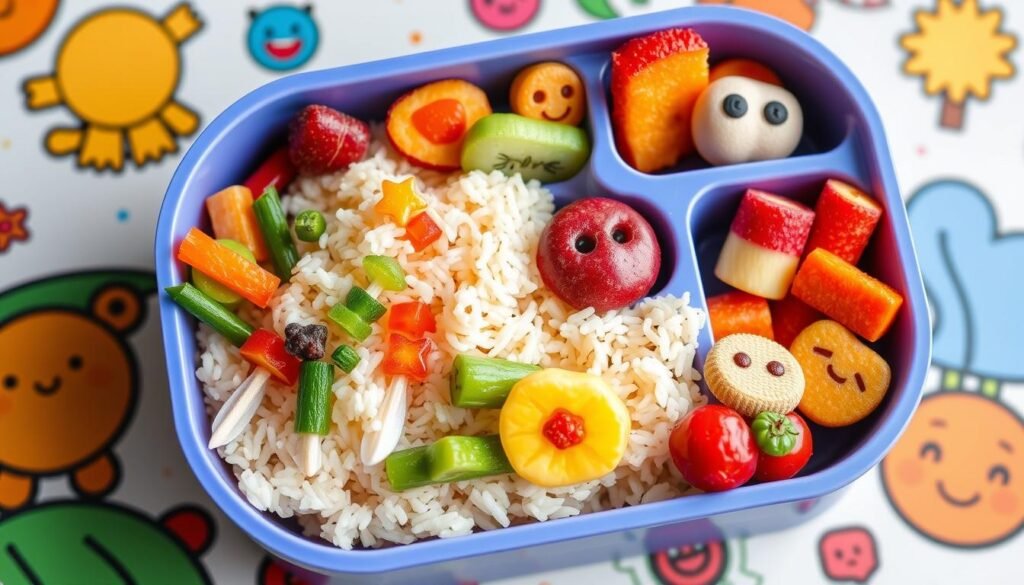
Colorful and Engaging Themes
Make bento boxes exciting with fun themes. You can create scenes like:
- Underwater ocean adventures
- Jungle animal landscapes
- Space exploration scenes
- Fairy tale character presentations
Shaped Foods and Fun Utensils
Make meals special with creative food shapes and fun utensils. Some great ideas include:
- Star-shaped sandwiches
- Flower-cut vegetables
- Character-themed food picks
- Dinosaur-shaped chicken nuggets
| Food Item | Fun Shape | Kid Appeal |
|---|---|---|
| Chicken Nuggets | Dinosaur Shapes | High |
| Sandwiches | Stars/Triangles | Medium |
| Fruits | Animal Cutouts | High |
Involving Kids in Preparation
Get kids involved in making lunch to make them more excited about eating healthy. Let them:
- Select ingredients
- Help arrange food items
- Choose theme decorations
- Pack their own lunchbox
“Making meals fun transforms nutrition into an exciting daily adventure for kids.”
By using these ideas, parents can make lunchtime a fun and healthy experience for kids.
Bento Box Packing Tips
Learning to pack lunch on-the-go can change how you plan meals. Bento Box Lunches are a creative and practical way to keep meals organized and tasty. The secret to packing a great bento box is in the preparation and organization.
Layering for Freshness
Layering is key to keeping food fresh. Here’s how to do it right:
- Put wet ingredients at the bottom of your bento box
- Place dry foods on top to avoid sogginess
- Use silicone dividers to keep foods separate
Preventing Food Damage
To keep your meal safe during transport, arrange it carefully:
- Use compact compartments to stop food from moving
- Choose bento boxes that are sturdy and have tight lids
- Wrap fragile items in softer foods
Packaging Sauces and Dressings
Small, leak-proof containers are essential for sauces. Remember these tips:
- Use mini sealed containers for dressings
- Keep sauces separate to keep food crisp
- Think about where to put sauces to avoid spills
“The secret to a perfect lunch is not just what you pack, but how you pack it.” – Bento Box Enthusiast
By following these tips, you’ll make packing lunch easy and enjoyable.
Keeping Your Bento Box Fresh
To keep your lunch fresh, focus on storage, temperature, and food safety. Good meal prep keeps your bento box tasty and safe all day.
Ideal Storage Conditions
Storing your bento box right is key to keeping food quality. Here are some important storage tips:
- Use insulated lunch bags with ice packs
- Keep bento boxes at temperatures below 46°F (8°C)
- Choose containers that maintain proper temperature
Reheating Solutions
Knowing how to reheat your bento box safely is part of easy meal planning. Here are some reheating tips:
- Heat foods to internal temperature of 158–165°F (70–75℃)
- Reheat for 1–2 minutes to eliminate potential bacteria
- Remove cold items before warming other components
Keeping Foods Safe
Food safety is crucial when making bento boxes. Important practices include:
- Wash hands thoroughly before food preparation
- Use clean utensils and cutting boards
- Avoid high-moisture ingredients in warm weather
- Clean bento boxes after each use
“Proper food handling transforms your bento box from a simple meal to a safe, delicious experience.”
By following these tips, you’ll make safe, fresh, and tasty lunches. These will keep you healthy and happy all day.
Conclusion: Embracing Bento Box Lunches
Bento Box Lunches are more than just a way to eat. They change how we view healthy eating. By diving into Japanese cuisine, you’ll see a new side of nutrition and meal planning.
Creating healthy lunches is more than just eating. The bento lifestyle opens up a world of food creativity. It makes every meal exciting. The boxes help you eat balanced and let you show off your food skills.
Benefits of a Bento Lifestyle
Using bento boxes has many benefits. They help with portion control, reduce waste, and add variety to your meals. You’ll start to think more about what you eat. You’ll try new things and eat more mindfully, following the Japanese way of eating.
Encouraging Creativity and Variety
Your bento box is a space for creativity. You can arrange veggies and add protein in different ways. Each meal is a chance to try new tastes and textures. A good bento box makes eating a fun, artistic experience.
Joining the Bento Community
Meet other bento fans online or in local groups. Share recipes and ideas. This way, you’ll keep improving your bento skills and join a worldwide community that loves to eat well.
FAQ
What exactly is a bento box?
A bento box is a Japanese lunch container with many compartments. It holds a single-portion meal with proteins, veggies, grains, and sometimes dessert. This design helps you make healthy, attractive meals with the right portion sizes.
Are bento boxes only for Japanese cuisine?
No, bento boxes now serve many cuisines and diets. They started in Japan but now include Western foods, salads, and international dishes. You can even find gluten-free, vegan, or nut-free options.
How do I keep my bento box lunch fresh?
To keep your lunch fresh, use an insulated bag with ice packs. Store it in a cool place and use the right containers for each food. Pack wet foods at the bottom and use dividers to keep things separate. Use thermos containers for warm foods to keep them at the right temperature.
What are some good protein options for bento boxes?
Good proteins include hard-boiled eggs, grilled chicken, and fish. You can also use tofu, falafel, turkey, chickpeas, and plant-based proteins like tempeh. Pick proteins that taste good cold or can be easily reheated.
How can I make bento boxes fun for kids?
To make bento boxes fun for kids, use creative themes like underwater scenes or jungle animals. Cut foods into fun shapes and use colorful fruits and veggies. Let kids help with making their lunches. Character-themed utensils and picks can also add excitement.
Are bento boxes environmentally friendly?
Yes, many bento boxes are eco-friendly. They’re made from sustainable materials like bamboo or stainless steel. They reduce waste by encouraging portion control and creative meal planning.
Can bento boxes accommodate dietary restrictions?
Yes! Bento boxes are great for different diets. You can make gluten-free meals with rice and other grains. Vegan meals use plant-based proteins. Nut-free lunches are possible by choosing the right ingredients. You can also customize compartments for specific dietary needs.
How far in advance can I prepare bento box lunches?
You can prep bento box parts 2-3 days in advance. Cook proteins and grains on weekends, wash and cut veggies, and store them in airtight containers. Assemble the final bento box the night before or morning to keep it fresh.
Source Links
- Easy Bento Lunch Box Ideas (Picky-Eater Approved) – https://www.yummytoddlerfood.com/easy-bento-lunch-box-ideas/
- Make the Best, Easy Bento Box Lunch for Kids – Call Me Grandma – https://www.callmegrandma.com/make-the-best-easy-bento-box-lunch-for-kids/
- Easy Bento Box Lunch Ideas – https://www.mjandhungryman.com/bento-box-school-lunch-ideas/
- What is a Bento Box? Unveiling the History and Tradition – https://umami-bento.com/blogs/infos/what-is-a-bento-box-history-and-tradition?srsltid=AfmBOoo8G4qQb4SHZs8Bq4KMWibslbdigVsZyEroqU41sGVvKW71CJaR
- We Tested 19 Bento Boxes—These 8 Will Make Your Packed Lunch Fun Again – https://www.thespruceeats.com/best-bento-boxes-4160950
- What is a Japanese Bento Box? History, Ingredients & More – https://www.byfood.com/blog/japanese-bento-box-p-586
- Building a Balanced Healthy Adult Bento Box – https://umami-bento.com/blogs/infos/building-a-balanced-healthy-adult-bento-box?srsltid=AfmBOor7SgqcL7M27Rcycz8mLj9dOCQAmgUfWJ4oEyNQAv8RpdIrBibF
- 10 Easy Healthy Bento Box Lunch Ideas for Work and School | ManluenPack – https://manluenpack.com/bento-box-lunch-ideas/
- How to Choose the Perfect Bento Box for Your Lifestyle – https://umami-bento.com/blogs/infos/choose-perfect-bento-box-for-your-lifestyle?srsltid=AfmBOop473hqCkQWth0Ellu7xxyfB9HiXmhdEK7XDZ8KKrwXvjgt6Oh7
- What is a Bento Box? Origin, Types & Buying Guide – https://www.thinkitchen.in/blogs/latest/what-is-a-bento-box?srsltid=AfmBOoqyGmgRHSaoH6dp6OrZjLb50wxioNCM08Rtoj00CRzAqPH9er9M
- What Types Of Bento Boxes Do You Know? – https://cn-crown.com/bento-box-type/
- 5 Easy Bento Box Lunch Ideas – The Girl on Bloor – https://thegirlonbloor.com/healthy-bento-lunch-box-recipes-5-ways/
- How To Pack a Bento Box Lunch for Kids – https://www.parents.com/how-to-pack-bento-8659309
- Balanced Bento Box Ideas from Publix Super Markets – https://www.publix.com/wellness/health-center/health-articles/balanced-bento-box-lunches
- 9 Creative Bento Box Lunch Ideas For Work, School, & Home | Easy Recipes — Ecowiser – https://wiser.eco/bento-box-lunch-ideas/
- Easy Bento Box Lunch Ideas for Kids and Toddlers – https://www.bbox.com/blogs/all/bento-box-lunch-ideas-for-kids-and-toddlers?srsltid=AfmBOopsqDgZFTT_pnyxWV1N–OS6OtrbyrXjmIRFn26dQj4aniknNA4
- 15 Easy Bento Box Ideas for Toddlers – https://www.happiestbaby.com/blogs/toddler/bento-box-ideas
- Vegetarian Bento Box – https://nourishedbynic.com/vegetarian-bento-box/
- How to Choose the Perfect Bento Box for Your Lifestyle – https://umami-bento.com/blogs/infos/choose-perfect-bento-box-for-your-lifestyle?srsltid=AfmBOooI0NGak_eDanRMyLBRBl5QaBQgd51oxBmo83aX377JceTCDs5x
- What is a Bento Box? Unveiling the History and Tradition – https://umami-bento.com/blogs/infos/what-is-a-bento-box-history-and-tradition?srsltid=AfmBOooe-B7zPE9H5kBb-VRa0G2RU9zL1c_hToGu_TDnLCCReI0EP2NC
- Bento Box School Lunch Ideas – Foods that Make the Grade | Macaroni KID Conejo Valley – Malibu – Calabasas – https://conejo-valley.macaronikid.com/articles/6148ae47ba5b41039d26a502/bento-box-school-lunch-ideas_-foods-that-make-the-grade
- Bento Lunch Box Ideas | Ain’t Too Proud To Meg – https://ainttooproudtomeg.com/kids-lunch-bento-boxes/
- Bento Boxes For Kids – https://www.eazypeazymealz.com/bento-boxes-for-kids/
- The Ultimate Guide to Kids Lunch Boxes: Why Bento Boxes Are a Game Cha – https://www.omielife.com/blogs/news/the-ultimate-guide-to-kids-lunch-boxes-why-bento-boxes-are-a-game-changer?srsltid=AfmBOooIc9ZiOkzjtrfY3nbgkIvJXaRsZs_mEeJX82woLNN1IGrLWtM5
- How To Pack Bento School Lunches Quickly – https://www.funwithmama.com/pack-bento-school-lunches-quickly/
- Caring for Your Bento Box: Tips for Longevity – https://umami-bento.com/blogs/infos/caring-for-your-bento-box-tips-for-longevity?srsltid=AfmBOoq_iddluylaBwZi_0fSHu5Gno4xvTjWCnHGfSZH2IcHlLHJ0JxD
- Food Safety Tips For Bento – https://www.justonecookbook.com/food-safety-tips-for-bento/
- What is a Bento Box? Unveiling the History and Tradition – https://umami-bento.com/blogs/infos/what-is-a-bento-box-history-and-tradition?srsltid=AfmBOoon9fNqNvrq3y6Yz1MaQqER8lIsdHb2RiyUgUOfPf-iJldITVlF
- How to Start a Bento Business – https://desygner.com/blog/industry/how-to-start-bento-business
- Designing a Bento Box Future: Embracing Societal Well-being and Mindful Creativity – https://uday-dandavate.medium.com/designing-a-bento-box-future-embracing-societal-well-being-and-mindful-creativity-eeeba8fb9c3b
- Mastering Bento Business Marketing: A Creative Guide – https://desygner.com/blog/industry/how-to-market-bento-business
